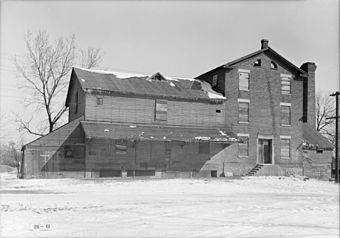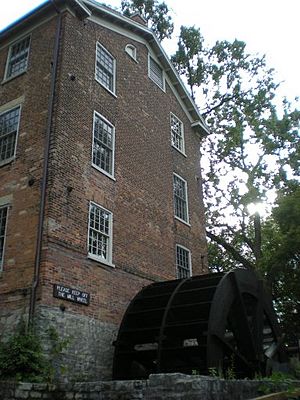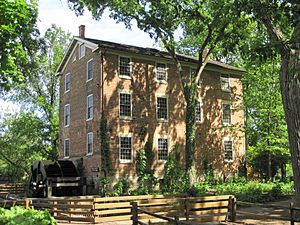Graue Mill facts for kids
Quick facts for kids |
|
|
Graue Mill in
|
|

Graue Water Mill
|
|
| Location | NW of jct. of Spring and York Rds., Oak Brook, Illinois |
|---|---|
| Built | 1852 |
| Architect | Graue, Frederick |
| NRHP reference No. | 75002077 |
| Added to NRHP | May 12, 1975 |
The Graue Mill is a special water-powered mill that was built way back in 1852. Today, it's a museum where you can learn all about how mills used to work. It's one of only two water-powered mills still running in Illinois. You can find it on Salt Creek in Oak Brook, Illinois. The Forest Preserve District of DuPage County owns and takes care of it.
Contents
The Mill's Story
Building the Mill
Frederick Graue was born in Germany and came to the United States in the late 1840s. He knew a lot about how to build and run water-powered mills. He settled in a farming village called Fullersburg, which was once known as Brush Hill.
In 1849, Frederick and his friend William Asche claimed some land by Salt Creek. There had been a sawmill there, but it had burned down. Together, they built a new sawmill. After three years, Frederick decided to build his own mill.
Frederick and his family dug ditches in the wet soil. They found lots of clay, which they used to make bricks. They built a special oven, called a kiln, on their farmstead to bake the bricks. Slowly, they built the new mill and put the big waterwheel in place. The Graue Mill started working in the summer of 1852.
Special Grinding Stones
Frederick couldn't build the whole mill from just what he found on his land. He bought four special grinding stones, called buhrstones. These stones came all the way from France! They were carefully shaped by skilled workers to have two rough, flat surfaces. When the waterwheel turned, these stones would spin and grind local corn and wheat into flour.
A Safe Place for Freedom
The Graue family were Pietist Germans, which meant they were very religious and believed that all people should be free. They were against American slavery. Because of their beliefs, the Graue Mill became a secret stop on the Underground Railroad. This was a hidden network that helped enslaved people escape from the southern United States to freedom in Canada. The Graue Mill is one of only three places in Illinois that were part of this important movement.
Graue Mill Today
The Graue family ran the mill for about 60 years. But in the 1910s, new machines like steel rolling mills were invented. These new mills could grind grain much faster and cheaper. Because of this, the old Graue Mill eventually stopped being a business.
Restoring the Mill
The mill was empty and unused for a while. But from 1934 to 1943, a group called the Civilian Conservation Corps helped fix it up. In 1951, it opened to the public as a working historic site. This means visitors can see how it used to operate.
As the area around the mill became more developed, the mill itself was recognized as a special piece of history. In 1975, the Graue Mill was added to the National Register of Historic Places. This is a list of important historical sites in the United States. In 1981, it was also named a Historic Mechanical Engineering Landmark, which means it's an important example of old machinery. The mill has been fixed up many times since 1943 to keep it in good working order, including repairs in 2002.
Visiting the Mill
The Graue Mill is located at 3800 S. York Road in Oak Brook, right by Salt Creek. It's surrounded by the beautiful Fullersburg woods. You can visit the mill and museum to see how it works and learn about its history. It's a great place to explore! You can check their website for visiting hours.
The mill is also close to the Salt Creek Trail. This trail follows Salt Creek and is a nice place for walking or biking.
Improving Salt Creek
To help the environment and the animals living in Salt Creek, a large dam near the mill was removed in December 2023. This project helped restore the natural flow of the creek, creating better places for fish and other wildlife. The mill's water wheel now uses a special pump system to get water, so it can still turn and show visitors how it used to work. There are also new viewing spots and a place to launch canoes or kayaks nearby.





